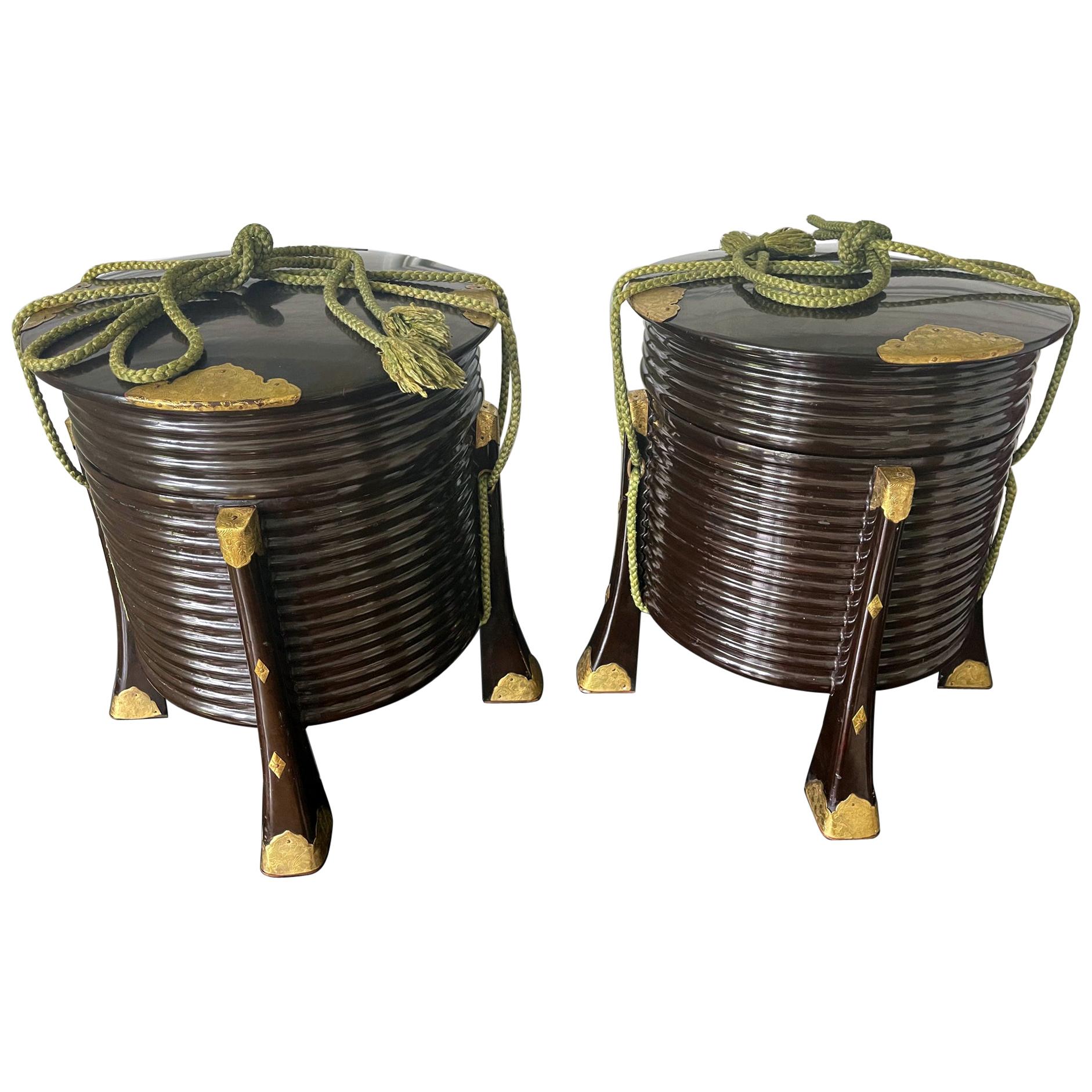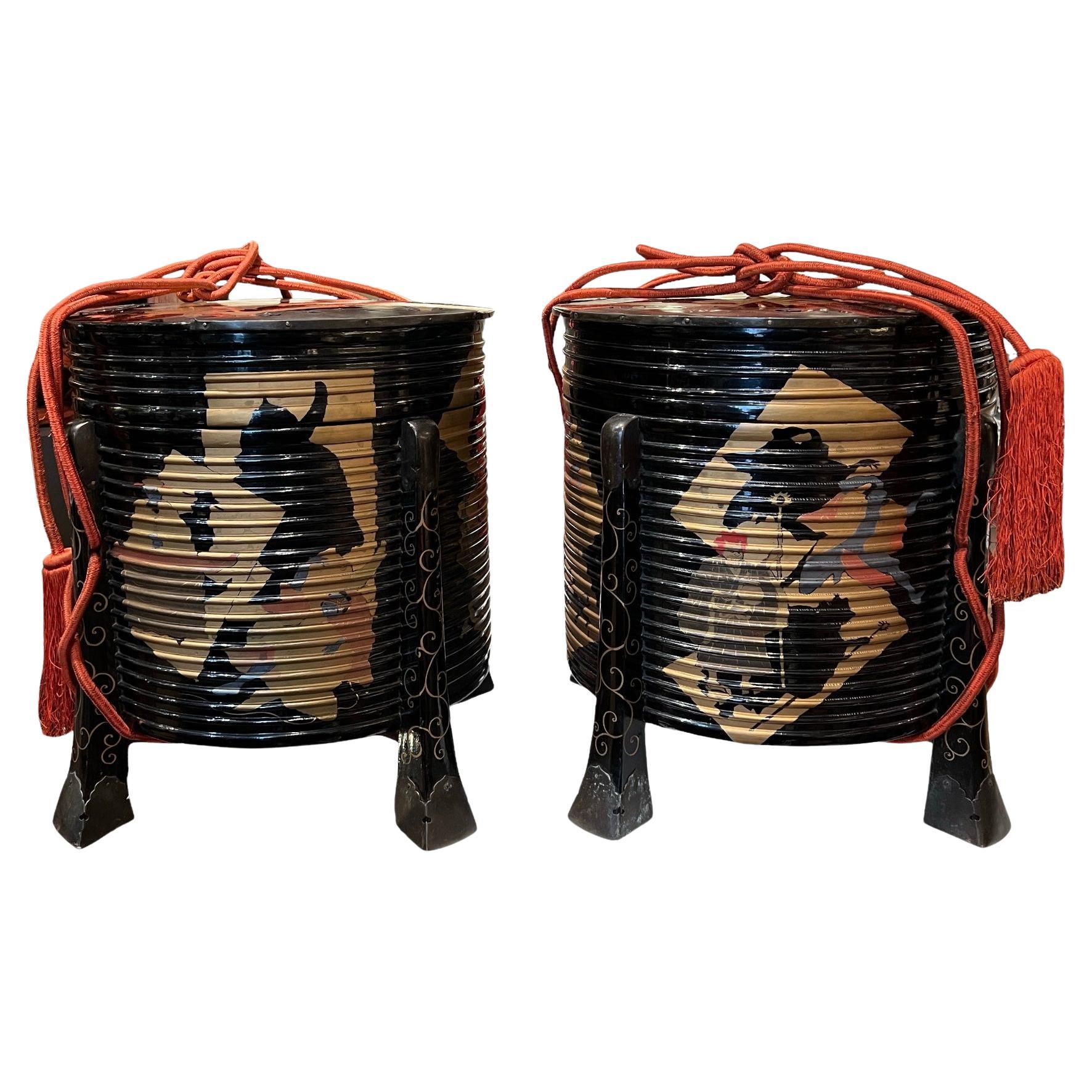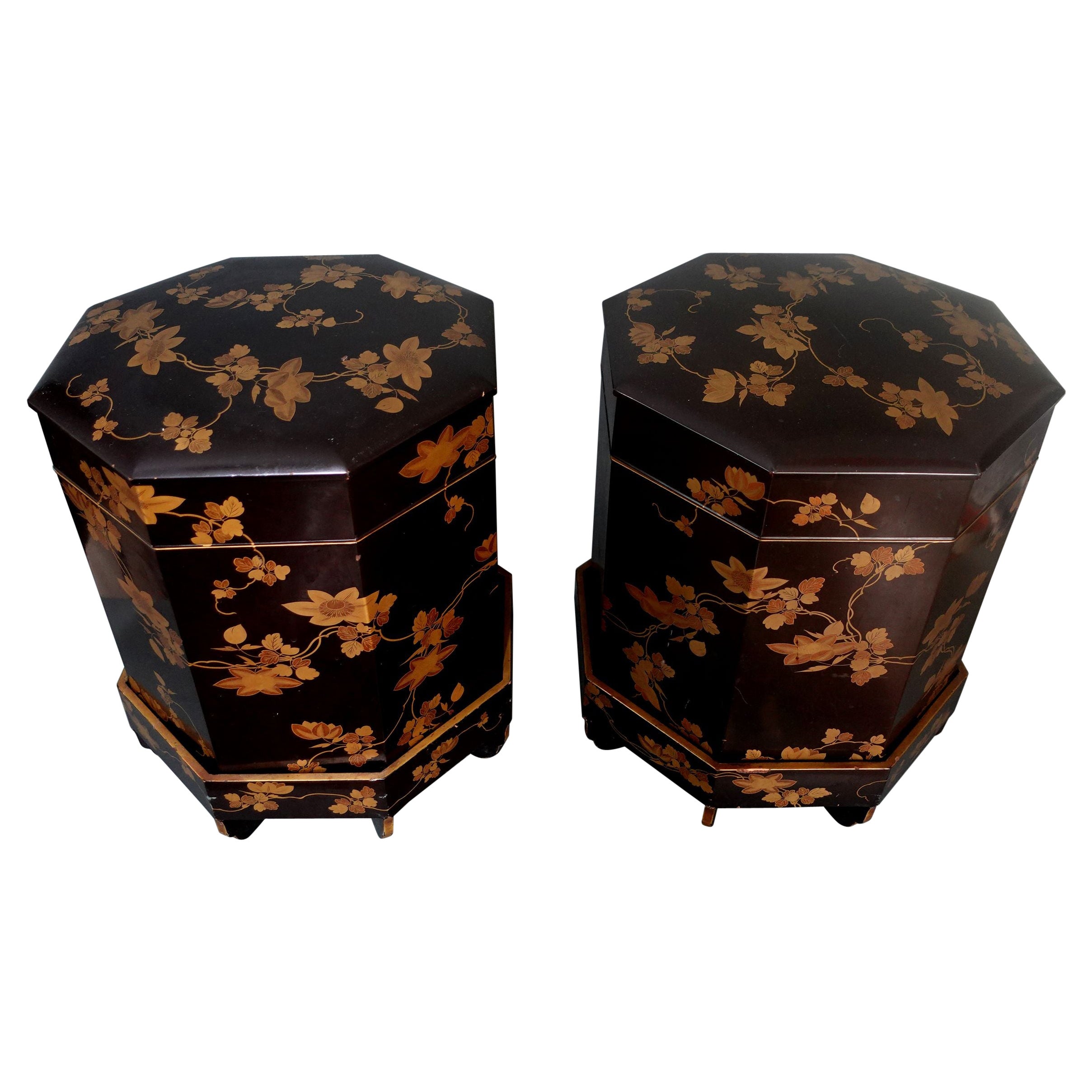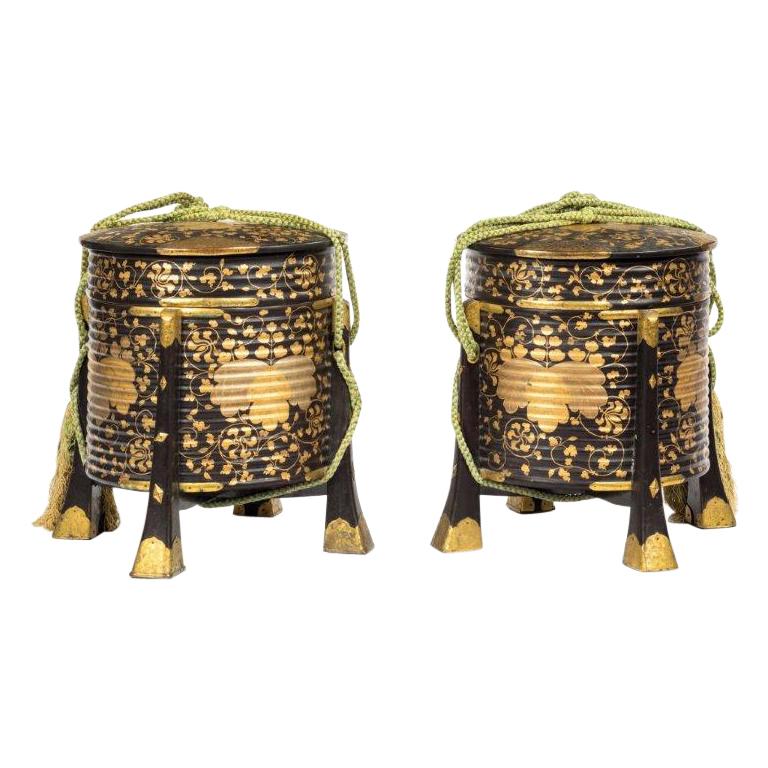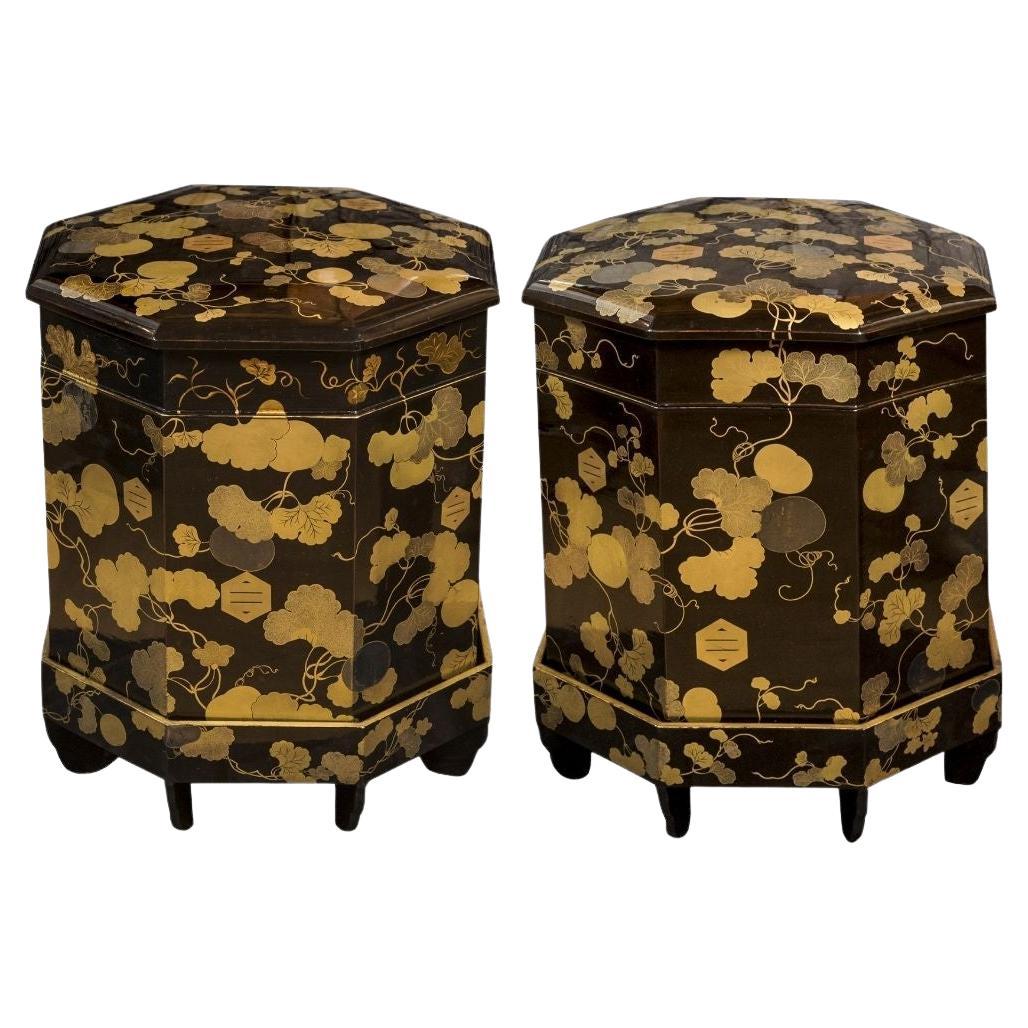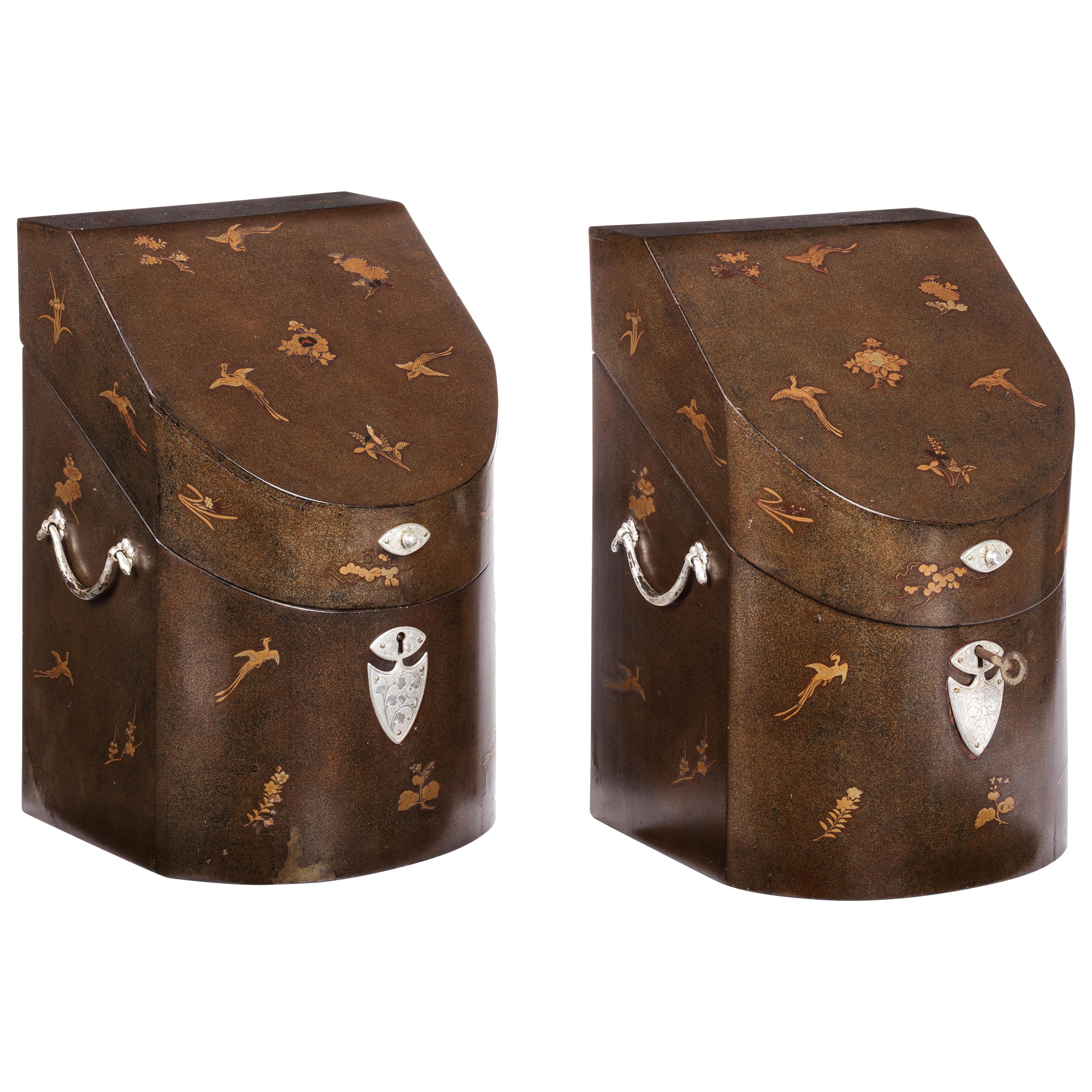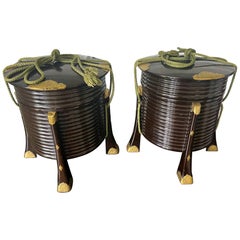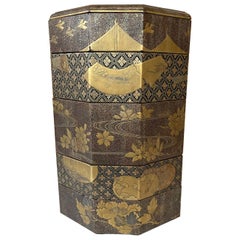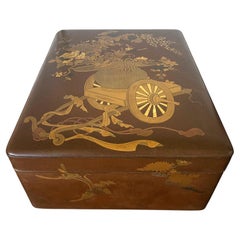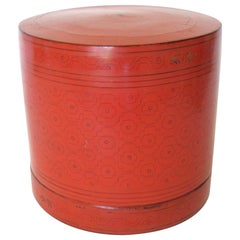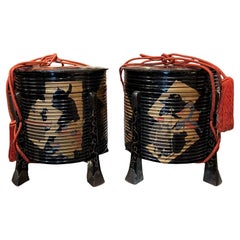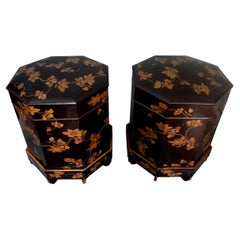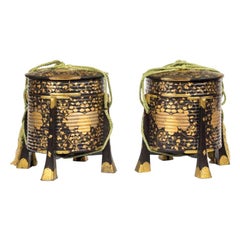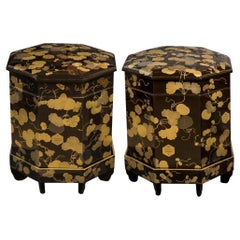Items Similar to Pair of Large Antique Japanese Hokai Lacquer Boxes
Want more images or videos?
Request additional images or videos from the seller
1 of 20
Pair of Large Antique Japanese Hokai Lacquer Boxes
$4,000per set
£3,016.40per set
€3,488.61per set
CA$5,611.98per set
A$6,238.06per set
CHF 3,269.86per set
MX$76,181.84per set
NOK 40,822.30per set
SEK 38,406.17per set
DKK 26,037.96per set
About the Item
A pair of Japanese lacquered lidded Hokai boxes with chased brass hardware and original ropes. Hokai boxes are traditionally used in Japan as the containers to store and carry shells for Kai-awase game in Edo and Meiji Period. Always in pair for the nature of the game, that is to find the matching halves of the shells, these storage containers with lids are fashioned in dark brown-black lacquer, supported by four slightly out-turned legs and decorated with elaborately engraved brass fittings. This pair will add a bespoken touch to any modern interior space due to the minimal exterior surface decoration.
Well preserved from the Meiji-Taisho period circa early part of 20th century, the boxes still retain the original orange ropes and a paper sticker inside with Kanji inscription.
- Dimensions:Height: 18.5 in (46.99 cm)Diameter: 16 in (40.64 cm)
- Sold As:Set of 2
- Style:Japonisme (Of the Period)
- Materials and Techniques:
- Place of Origin:
- Period:
- Date of Manufacture:Early 20th Century
- Condition:Wear consistent with age and use. Good overall condition. Expected scattered surface patina such as scratches, scrapes indentations and chips, some with touchups throughout. May be hard to see due to the reflective surface. Brass with patina. Ropes are worn faded.
- Seller Location:Atlanta, GA
- Reference Number:1stDibs: LU945029486612
About the Seller
4.9
Platinum Seller
Premium sellers with a 4.7+ rating and 24-hour response times
Established in 2006
1stDibs seller since 2010
567 sales on 1stDibs
Typical response time: <1 hour
- ShippingRetrieving quote...Shipping from: Atlanta, GA
- Return Policy
Authenticity Guarantee
In the unlikely event there’s an issue with an item’s authenticity, contact us within 1 year for a full refund. DetailsMoney-Back Guarantee
If your item is not as described, is damaged in transit, or does not arrive, contact us within 7 days for a full refund. Details24-Hour Cancellation
You have a 24-hour grace period in which to reconsider your purchase, with no questions asked.Vetted Professional Sellers
Our world-class sellers must adhere to strict standards for service and quality, maintaining the integrity of our listings.Price-Match Guarantee
If you find that a seller listed the same item for a lower price elsewhere, we’ll match it.Trusted Global Delivery
Our best-in-class carrier network provides specialized shipping options worldwide, including custom delivery.More From This Seller
View AllPair of Large Antique Japanese Hokai Lacquer Boxes
Located in Atlanta, GA
A pair of Japanese lacquer lidded Hokai boxes with chased brass hardware and original ropes. Hokai boxes are traditionally used in Japan to store and carry s...
Category
Early 20th Century Japanese Japonisme Lacquer
Materials
Wood, Lacquer
Japanese Maki-e Lacquer Stack Box Jubako
Located in Atlanta, GA
An antique jubako (stack boxes) with five tiers in an elongated octagon shape circa 19th century (end of Edo or beginning of Meiji period). jubako was traditionally used to store and...
Category
Antique 19th Century Japanese Japonisme Lacquer
Materials
Wood, Lacquer
Japanese Lacquer Ryoshibako Document Box Meiji Period
Located in Atlanta, GA
A large Japanese lacquer box with elaborate Maki-e design from Meiji period, (mid-late 19th century). The generous size of the box was reser...
Category
Antique 19th Century Japanese Japonisme Lacquer
Materials
Wood, Lacquer
Early 20th Century, Large Burmese Betel Box, “Kun It”
Located in Atlanta, GA
Burmese (Myanmar) Lacquerware has a long tradition dating back to the 13th Century. Lacquer in Burma is called “Thitsi” meaning the sap of a Thitsi Tree (Melanhorrea Usitata). Typica...
Category
Early 20th Century Burmese Lacquer
Materials
Bamboo, Lacquer
Japanese Lacquer Maki-E Tiered Suzuribako and Ryoshibako
Located in Atlanta, GA
A Japanese roiro lacquer scholar combo box with an upper tier of inkstone box (Suzuribako) and a lower document box (Ryoshibako) circa 1910-30s (end of Meiji to Showa period). The high glossy box was beautifully decorated with an image of the famously eccentric Buddhist monks Hanshan and Shide (known in Japan as Kanzan and Jittoku). Often as a pair, they have been a popular motif in Japanese Zen painting...
Category
Vintage 1920s Japanese Meiji Lacquer
Materials
Stone, Metal
Set of Two Antique Japanese Ceramic Ko-Seto Chaires
Located in Atlanta, GA
A collection of two ceramic chaires (Tea caddies) of Ko-seto ware type from Edo period Japan circa 17-18th century. This type of small jar was made of stoneware in old Seto kilns in ...
Category
Antique 18th Century Japanese Edo Ceramics
Materials
Ceramic
You May Also Like
Japan, Pair of Hokai boxes in lacquered wood, Edo period, 1829
Located in PARIS, FR
Japan, Pair of Hokai boxes in lacquered wood, Edo period, 1829
Japan, Rare Pair of Hokai boxes in lacquered wood, Edo period, dated Bunsei 12, 1829.
Hokai boxes are traditionally use...
Category
Antique 19th Century Japanese Chinoiserie Decorative Boxes
Materials
Lacquer
A Pair of Large Japanese Lacquer Kaioke Boxes
Located in Norton, MA
Japan, late Edo, two big octagonal covered shell game boxes resting on footed stands, with makie-e decorations depicting flowering vines on a black lacquer ground,
They are still in ...
Category
Antique 19th Century Japanese Decorative Boxes
Materials
Lacquer
$18,500 / set
Pair of Edo Period Black and Gold Lacquer Samurai Helmet Boxes
Located in Lymington, Hampshire
A pair of Edo period black and gold lacquer Samurai helmet boxes (Hakko Bako), each of ribbed cylindrical form with a lid, a black lacquer interior,...
Category
Antique 19th Century Japanese Edo Lacquer
Materials
Lacquer
Japanese pair of kaioke boxes or Hokkaibako made of black and gold lacquer
Located in PARIS, FR
Two large eight-sided kaioke boxes in black lacquer, decorated with mon and maple leaves in golden lacquer.
These are usually octagonal boxes containing the painted shells used in ...
Category
Antique Late 19th Century Japanese Meiji Lacquer
Materials
Gold
Pair of Fine Japanese Export Lacquer Cutlery Knife Boxes, 18th Century
Located in Amsterdam, NL
A pair of fine Japanese export lacquered cutlery boxes
Kyoto or Nagasaki, late 18th century
H. 33.5 x W. 24 x D. 21 cm
The bow-fronted boxes with sloping lids flat at the top are made of hinoki wood (Cypress), coated with Japanese paper and decorated in lacquer with scattered gold birds and flowers on a nashiji background. The Japanese mounts are made of copper and both boxes still have internal partitions to keep the cutlery upright.
The form of these boxes is similar to a pictorial-style knife box in the collection of the Groninger Museum (inv. 1989- 347), dated between 1730 and 1780, but the style of the decoration is more like that on a knife box in the Peabody Essex Museum in Salem (inv. E62271), which was brought to Salem by James Devereux, Captain of the Franklin, in 1799.
Provenance:
Henriette Jeane Christine van Neukirchen, called Nyvenheim (1807- 1849) and Nicolaas Johan Steengracht van Oostcapelle (1806-1866), thence by descent to the last owners, Ludolphine Emilie baronesse Schimmelpenninck van der Oye (1944) married in 1969 to Roland Daniel van Haersma Buma (1944), the last residents of castle Duivenvoorden near Voorschoten and the great-great-granddaughter of Nicolaas Johan Steengracht van Oostcapelle.
There is no evidence that Nicolaas Johan himself, or any of his or his wife’s ancestors had ever been in Japan. However, Nicolaas’ grandfather (Nicolaas Steengracht, 1754-1840) was a director of both the VOC and WIC (West Indies Company...
Category
Antique Late 18th Century Japanese Lacquer
Materials
Silver
Rare pair of Japanese Nagasaki Export Lacquered Wood Knife Boxes
Located in Stamford, CT
Rare pair of Japanese Nagasaki Export lacquered wood knife boxes with mother-of-pearl inlay of flowers and birds, now converted to letter boxes...
Category
Antique Early 19th Century Japanese Anglo-Japanese Knife Boxes
Materials
Wood
More Ways To Browse
Black Lacquer Storage
Orange Lacquer
Antique Lacquer Box
Antique Lacquer Boxes
Lacquered Boxes Modern
Japanese Containers
Japanese Lacquer Boxes
Asian Storage Box
Lacquered Large Boxes
Black Lacquered Boxes
Orange Japanese Antique
Large Lacquer Box
Japanese Hardware
Wood Carrying Box
Black Lacquer With Brass Hardware
Japanese Shell Art
Antique Storage Containers
Asian Brass Wood Box
